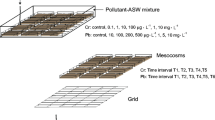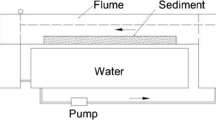Abstract
Experiments were designed to expose the filter-feeding bivalvePerna viridis to different Cd-contaminated water environments in order to compare the different pathways through which Cd is accumulated. Results show that mussels can accumulate Cd through seawater, food, sediment and suspended particle pathways in a short period of time. Mussels' uptake of Cd through the seawater pathway reaches the highest concentration approximately 3 and 9 times larger than through the algae and sediment pathways respectively after 7 d. This indicates that the Cd-accumulation through seawater is most efficient. Results also indicate that the uptake directly through contaminated algae, particles or sediments ingested by mussels is less important when compared with the uptake of Cd by mussels through the seawater pathway. Metal uptake pathways and mechanisms of bioaccumulation by marine bivalve are also discussed in this paper.
Similar content being viewed by others
References
Allen, S. E., H. M. Grimshaw, J. A. Parkinson, and C. Quarmby, 1974.Chemical Analysis of Ecological Materials. Blackwell, Oxford, 565 pp.
Amiard, J. C., C. Metayer, J. P. Baud, and F. Ribeyer, 1994. Influence of some ecological and biological factors on metal bioaccumulation in young oysters (Crassostrea gigas Thunberg).Water Res.,28 (1): 219–231.
Borchardt, T., 1983. Influence of food quantity on the kinetics of cadmium uptake and loss via food and seawater inMytilus edulis.Mar. Biol.,76: 67–76.
Bryan, G. W., and H. Uysal, 1978. Heavy metals in the burrowing bivalvesScrobicularia plana from the Tamar Estuary in relation to environmental levels.J. Mar. Biol. Assoc. UK,58: 89–108.
Chan, H. M., 1988. Bioaccumulation and tolerance to cadmium, copper, lead and zinc by the green musselPernaviridis.Mar. Ecol. Prog. Ser.,48: 295–303.
Cheung, Y. H., and M. H. Wong, 1993. Toxic effects of dredged sediments of Hong Kong coastal waters on clams.Environ. Technol.,14: 1047–1055.
Cheung, Y. H., and M. H. Wong, 1997. Depuration and bioaccumulation of heavy metals by clams from Tolo Harbour, Hong Kong.Toxicol. Environ. Chem.,58: 103–116.
Cunningham, P. A., and M. R. Tripp, 1975. Accumulation, tissue distribution and elimination of203HgCl2 and CH 2033 HgCl in the tissues of the American oysterCrassostrea virginica.Mar. Environ. Res.,39: 169–173.
Fang, Z., 2003. Comparative studies on the uptake way of polychlorinated biphenyls by green-lipped mussels (Perna viridis).J. Trop. Oceanogr.,22 (5): 63–70 (in Chinese).
Fang, Z., R. Y. H. Cheung, and M. H. Wong, 2003. Heavy metals in oysters, mussels and clams collected from coastal sites along the Pearl River Delta, South China.J. Environ. Sci.,15 (1): 9–24.
Guillard, R. R. L., 1975. Culture of phytoplankton for feeding marine invertebrates. In:Culture of Marine Invertebrate Animals. Smith, W. L., and Chanley M. H., eds., Plenum Press, New York, 29–60.
Klerks, P. L., and P. C. Fraleigh, 1997. Uptake of nickel and zinc by the zebra musselDreissena polymorpha.Arch. Environ. Contam. Toxicol.,39: 191–197.
Loring, D. H., and F. Prosi, 1986. Cadmium and lead cycling between water, sediment, and biota in an artificially contaminated mud flat on Borkum (F. R. G.).Wat. Sci. Technol.,18: 131–139.
Luoma, S. N., and E. A. Jenne, 1977. The availability of sediment-bound cobalt, silver, and zinc to a deposit-feeding clam. In:Biological Implications of Metals in the Environment, CONF-750929. Wildung, R. E., and Drucker, H., eds., Academic Press, New York, 315–339.
Luoma, S. N., and J. A. Davis, 1983. Requirements for modeling trace metal partitioning in oxidized estuarine sediments.Mar. Chem.,12: 159–181.
Luoma, S. N., 1989. Can we determine the biological availability of sediment-bound trace elements?Hydrobiologia,176/177: 379–396.
Naimo, T. J., 1995. A review of the effects of heavy metals on freshwater mussels.Ecotoxicology,4: 341–362.
Phillips, D. J. H., 1979. Trace metals in the common musselMytilus edukis (L.) and in the algaeFucus vesiculosus (L.) from the region of the sound (resund).Environ. Pollut.,18: 31–43.
Riisgård, H. U., E. Bjirnestad, and F. Måhlenberg, 1987. Accumulation of cadmium in the musselMytilus edulis: kinetics and importance of uptake via food and seawater.Mar. Biol.,96: 349–353.
Spring, M., and U. Rose, 1988. Influence of food size and food quantity on the feeding of the musselDreissena polymorpha.Oecologia,77: 526–325.
Tessier, A., and P. G. C. Campbell, 1987. Partitioning of trace metals in sediments: relationships with bioavailability.Hydrobiologia,149: 43–52.
The Plan Committee of Guangdong province and the Office of Researches on Perspective Plant for the Pearl River Delta Economic Region, 1995.Researches on Perspective Plan for the Pearl River Delta Economic Region, Vol. I. Guangdong Economic Press, Guangzhou, 127–166 (in Chinese).
Wang, W. X., and N. S. Fisher, 1996. Assimilation of trace elements by the musselMytilus edulis: effects of diatom chemical composition.Mar. Biol.,125: 715–724.
Yang, M. S., S. T. Chiu, and M. H. Wong, 1995. Uptake, depuration and subcellular distribution of cadmium in various tissues ofPerna virid.Biomed. Environ. Sci.,8: 176–185.
Author information
Authors and Affiliations
Corresponding author
Rights and permissions
About this article
Cite this article
Zhanqiang, F. Comparative studies on uptake pathway of cadmium byPerna viridis . J. Ocean Univ. China 5, 49–54 (2006). https://doi.org/10.1007/BF02919373
Received:
Accepted:
Issue Date:
DOI: https://doi.org/10.1007/BF02919373




